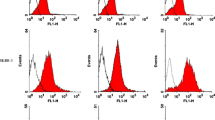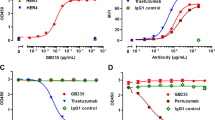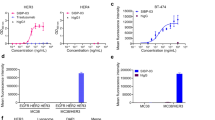Abstract
Purpose
The therapeutic potential of targeting the human epidermal growth factor receptor-3 (ErbB3/HER3) has long been ignored due to impaired tyrosine kinase function and low expression level in tumor cells compared with EGFR and HER2. Although recent investigations have explored the potential benefit of HER3 targeting and several anti-HER3 agents have been developed, there is still a critical need to design and produce more efficient therapeutics. This study was designed to develop tumor inhibitory monoclonal antibodies (MAbs) against different extracellular subdomains of HER3.
Methods
Distinct extracellular subdomains of HER3 (DI+II and DIII+IV) were utilized to produce MAbs by hybridoma technology. Biochemical and functional characteristics of these MAbs were then investigated by various methodologies, including immunoblotting, flow cytometry, cell proliferation, cell signaling, and enzyme-linked immunosorbent assays.
Results
Four anti-DI+II and six anti-DIII+IV MAbs were obtained, selected based on their ability to bind recombinant full HER3 extracellular domain (ECD). Our data showed that only one anti-DI+II and four anti-DIII+IV MAbs recognized the native form of HER3 by immunoblotting. Four MAbs recognized the membranous HER3 by flow cytometry leading to induction of different levels of receptor internalization and subsequent degradation. Results of cell proliferation assays using these MAbs indicated that they differentially inhibited proliferation of HER3-expressing cancer cells and showed considerable synergistic effects in combination with trastuzumab. Selected MAb with the highest inhibitory effect significantly inhibited the phosphorylation of AKT and ERK1/2 molecules.
Conclusion
Some of the anti-HER3 MAbs produced in this study displayed tumor inhibitory function and may be considered promising candidates for future HER3-targeted cancer therapy.








Similar content being viewed by others
Availability of data and materials
The datasets generated during and/or analyzed during the current study are available from the corresponding author on reasonable request.
Code availability
Not applicable.
References
Wieduwilt MJ, Moasser MM (2008) The epidermal growth factor receptor family: biology driving targeted therapeutics. Cell Mol Life Sci 65(10):1566–1584. https://doi.org/10.1007/s00018-008-7440-8
Mishra R, Patel H, Alanazi S, Yuan L, Garrett JT (2018) HER3 signaling and targeted therapy in cancer. Oncol Rev 12(1):45–62. https://doi.org/10.4081/oncol.2018.355
Gala K, Chandarlapaty S (2014) Molecular pathways: HER3 targeted therapy. Clin Cancer Res 20(6):1410–1416. https://doi.org/10.1158/1078-0432.CCR-13-1549
Kol A, Terwisscha van Scheltinga AGT, Timmer-Bosscha H, Lamberts LE, Bensch F, de Vries EGE, Schröder CP (2014) HER3, serious partner in crime: therapeutic approaches and potential biomarkers for effect of HER3-targeting. Pharmacol Ther 143(1):1–11. https://doi.org/10.1016/j.pharmthera.2014.01.005
Baselga J, Swain SM (2009) Novel anticancer targets: revisiting ErbB2 and discovering ErbB3. Nat Rev Cancer 9(7):463–475. https://doi.org/10.1038/nrc2656
Wang J, Xu B (2019) Targeted therapeutic options and future perspectives for HER2-positive breast cancer. Signal Transduct Target Ther 4(1):1–22. https://doi.org/10.1038/s41392-019-0069-2
Oh DY, Bang YJ (2020) HER2-targeted therapies—a role beyond breast cancer. Nat Rev Clin Oncol 17(1):33–48. https://doi.org/10.1038/s41571-019-0268-3
Wang J, Xu B (2019) Targeted therapeutic options and future perspectives for HER2-positive breast cancer. Signal Transduct Target Ther 4:1–22. https://doi.org/10.1038/s41392-019-0069-2
Campbell MR, Amin D, Moasser MM (2010) HER3 comes of age: new insights into its functions and role in signaling, tumor biology, and cancer therapy. Clin Cancer Res 16(5):1373–1383. https://doi.org/10.1158/1078-0432.CCR-09-1218
Lyu H, Han A, Polsdofer E, Liu S, Liu B (2018) Understanding the biology of HER3 receptor as a therapeutic target in human cancer. Acta Pharm Sin B 8(4):503–510. https://doi.org/10.1016/j.apsb.2018.05.010
Karachaliou N, Lazzari C, Verlicchi A, Sosa AE, Rosell R (2017) HER3 as a therapeutic target in cancer. BioDrugs 31(1):63–73. https://doi.org/10.1007/s40259-016-0205-2
Haikala HM, Jänne PA (2021) Thirty years of HER3: from basic biology to therapeutic interventions. Clin Cancer Res 27(13):3528–3539. https://doi.org/10.1158/1078-0432.CCR-20-4465
Jacob W, James I, Hasmann M, Weisser M (2018) Clinical development of HER3-targeting monoclonal antibodies: perils and progress. Cancer Treat Rev 68:111–123. https://doi.org/10.1016/j.ctrv.2018.06.011
Mansouri-Fard S, Ghaedi M, Shokri MR, Bahadori T, Khoshnoodi J, Golsaz-Shirazi F, Jeddi-Tehrani M et al (2020) Inhibitory effect of polyclonal antibodies against HER3 extracellular subdomains on breast cancer cell lines. Asian Pac J Cancer Prev 21(2):439–447. https://doi.org/10.31557/APJCP.2020.21.2.439
Hassani D, Amiri MM, Mohammadi M, Yousefi P, Judaki MA, Mobini M, Golsaz-Shirazi F et al (2021) A novel tumor inhibitory hybridoma monoclonal antibody with dual specificity for HER3 and HER2. Curr Res Transl Med 69(2):1–9. https://doi.org/10.1016/j.retram.2021.103277
Kazemi T, Tahmasebi F, Bayat AA, Mohajer N, Khoshnoodi J, Jeddi-Tehrani M, Rabbani H et al (2011) Characterization of novel murine monoclonal antibodies directed against the extracellular domain of human HER2 tyrosine kinase receptor. Hybridoma 30(4):347–353
Beatty JD, Beatty BG, Vlahos WG (1987) Measurement of monoclonal antibody affinity by non-competitive enzyme immunoassay. J Immunol Methods 100(1–2):173–179. https://doi.org/10.1016/0022-1759(87)90187-6
Hajighasemi F, Saboor-Yaraghi AA, Shokri F (2004) Measurement of affinity constant of anti-human IgG monoclonal antibodies by an ELISA-based method. Iran J Immunol 1(3):154–161
Maadi H, Soheilifar MH, Choi W-S, Moshtaghian A, Wang Z (2021) Trastuzumab mechanism of action; 20 years of research to unravel a dilemma. Cancers 13(14):1–17. https://doi.org/10.3390/cancers13143540
Blackburn E, Zona S, Murphy ML, Brown IR, Chan SKW, Gullick WJ (2012) A monoclonal antibody to the human HER3 receptor inhibits neuregulin 1-beta binding and co-operates with Herceptin in inhibiting the growth of breast cancer derived cell lines. Breast Cancer Res Treat 134(1):53–59. https://doi.org/10.1007/s10549-011-1908-1
Tanner M, Kapanen AI, Junttila T, Raheem O, Grenman S, Elo J, Elenius K et al (2004) Characterization of a novel cell line established from a patient with Herceptin-resistant breast cancer. Mol Cancer Ther 3(12):1585–1592
Shu M, Yan H, Xu C, Wu Y, Chi Z, Nian W, He Z et al (2020) A novel anti-HER2 antibody GB235 reverses trastuzumab resistance in HER2-expressing tumor cells in vitro and in vivo. Sci Rep 10:1–12. https://doi.org/10.1038/s41598-020-59818-2
Gaborit N, Abdul-Hai A, Mancini M, Lindzen M, Lavi S, Leitner O, Mounier L et al (2015) Examination of HER3 targeting in cancer using monoclonal antibodies. Proc Natl Acad Sci USA 112(3):839–844. https://doi.org/10.1073/pnas.1423645112
Köninki K, Barok M, Tanner M, Staff S, Pitkänen J, Hemmilä P, Ilvesaro J et al (2010) Multiple molecular mechanisms underlying trastuzumab and lapatinib resistance in JIMT-1 breast cancer cells. Cancer Lett 294(2):211–219. https://doi.org/10.1016/j.canlet.2010.02.002
Arteaga CL, Engelman JA (2014) ErbB receptors: from oncogene discovery to basic science to mechanism-based cancer therapeutics. Cancer Cell 25(3):282–303. https://doi.org/10.1016/j.ccr.2014.02.025
Masoud V, Pagès G (2017) Targeted therapies in breast cancer: new challenges to fight against resistance. World J Clin Oncol 8(2):120–134. https://doi.org/10.5306/wjco.v8.i2.120
Hafeez U, Parslow AC, Gan HK, Scott AM (2020) New insights into ErbB3 function and therapeutic targeting in cancer. Expert Rev Anticancer Ther 20(12):1057–1074. https://doi.org/10.1080/14737140.2020.1829485
Black LE, Longo JF, Carroll SL (2019) Mechanisms of receptor tyrosine-protein kinase ErbB-3 (ERBB3) action in human neoplasia. Am J Pathol 189(10):1898–1912. https://doi.org/10.1016/j.ajpath.2019.06.008
Okita K, Okazaki S, Uejima S, Yamada E, Kaminaka H, Kondo M, Ueda S et al (2020) Novel functional anti-HER3 monoclonal antibodies with potent anti-cancer effects on various human epithelial cancers. Oncotarget 11(1):31–45. https://doi.org/10.18632/oncotarget.27414
Schmitt LC, Rau A, Seifert O, Honer J, Hutt M, Schmid S, Zantow J et al (2017) Inhibition of HER3 activation and tumor growth with a human antibody binding to a conserved epitope formed by domain III and IV. MAbs 9(5):831–843. https://doi.org/10.1080/19420862.2017.1319023
Thakkar D, Sancenon V, Taguiam MM, Guan S, Wu Z, Ng E, Paszkiewicz KH et al (2020) 10D1F, an anti-HER3 antibody that uniquely blocks the receptor heterodimerization interface, potently inhibits tumor growth across a broad panel of tumor models. Mol Cancer Ther 19(2):490–501. https://doi.org/10.1158/1535-7163.MCT-19-0515
Li Q, Yuan Z, Cao B (2013) The function of human epidermal growth factor receptor-3 and its role in tumors. Oncol Rep 30(6):2563–2570. https://doi.org/10.3892/or.2013.2754
Jiang N, Saba NF, Chen ZG (2012) Advances in targeting HER3 as an anticancer therapy. Chemother Res Pract 2012:1–9. https://doi.org/10.1155/2012/817304
Ferraro DA, Gaborit N, Maron R, Cohen-Dvashi H, Porat Z, Pareja F, Lavi S et al (2013) Inhibition of triple-negative breast cancer models by combinations of antibodies to EGFR. Proc Natl Acad Sci USA 110(5):1815–1820. https://doi.org/10.1073/pnas.1220763110
Iida M, Brand TM, Starr MM, Li C, Huppert EJ, Luthar N, Pedersen MW et al (2013) Sym004, a novel EGFR antibody mixture, can overcome acquired resistance to cetuximab. Neoplasia 15(10):1196–1206. https://doi.org/10.1593/neo.131584
Ben-Kasus T, Schechter B, Lavi S, Yarden Y, Sela M (2009) Persistent elimination of ErbB2-/HER2-overexpressing tumors using combinations of monoclonal antibodies: relevance of receptor endocytosis. Proc Natl Acad Sci USA 106(9):3294–3299. https://doi.org/10.1073/pnas.0812059106
Soltantoyeh T, Bahadori T, Hosseini-Ghatar R, Khoshnoodi J, Roohi A, Mobini M, Golsaz-Shirazi F et al (2018) Differential effects of inhibitory and stimulatory anti-HER2 monoclonal antibodies on AKT/ERK signaling pathways. Asian Pac J Cancer Prev 19(8):2255–2262. https://doi.org/10.22034/APJCP.2018.19.8.2255
Gaborit N, Lindzen M, Yarden Y (2016) Emerging anti-cancer antibodies and combination therapies targeting HER3/ErbB3. Hum Vaccin Immunother 12(3):576–592. https://doi.org/10.1080/21645515.2015.1102809
Mishra R, Alanazi S, Yuan L, Solomon T, Thaker TM, Jura N, Garrett JT (2018) Activating HER3 mutations in breast cancer. Oncotarget 9(45):27773–27788. https://doi.org/10.18632/oncotarget.25576
Kiavue N, Cabel L, Melaabi S, Bataillon G, Callens C, Lerebours F, Pierga J-Y et al (2020) ErbB3 mutations in cancer: biological aspects, prevalence and therapeutics. Oncogene 39(3):487–502. https://doi.org/10.1038/s41388-019-1001-5
Almeida JG, Preto AJ, Koukos PI, Bonvin AMJJ, Moreira IS (2017) Membrane proteins structures: a review on computational modeling tools. Biochim Biophys Acta Biomembr 1859(10):2021–2039. https://doi.org/10.1016/j.bbamem.2017.07.008
Hatano R, Yamada T, Madokoro H, Otsuka H, Komiya E, Itoh T, Narita Y et al (2019) Development of novel monoclonal antibodies with specific binding affinity for denatured human CD26 in formalin-fixed paraffin-embedded and decalcified specimens. PLoS ONE 14(6):1–19. https://doi.org/10.1371/journal.pone.0218330
Revelen R, D Arbonneau F, Guillevin L, Bordron A, Youinou P, Dueymes M (2002) Comparison of cell-ELISA, flow cytometry and Western blotting for the detection of antiendothelial cell antibodies. Clin Exp Rheumatol 20(1):19–26
Stravinskiene D, Sliziene A, Baranauskiene L, Petrikaite V, Zvirbliene A (2020) Inhibitory monoclonal antibodies and their recombinant derivatives targeting surface-exposed carbonic anhydrase XII on cancer cells. Int J Mol Sci 21(24):1–26. https://doi.org/10.3390/ijms21249411
Hashimoto Y, Koyama K, Kamai Y, Hirotani K, Ogitani Y, Zembutsu A, Abe M et al (2019) A novel HER3-targeting antibody–drug conjugate, U3–1402, exhibits potent therapeutic efficacy through the delivery of cytotoxic payload by efficient internalization. Clin Cancer Res 25(23):7151–7161. https://doi.org/10.1158/1078-0432.CCR-19-1745
Garner AP, Bialucha CU, Sprague ER, Garrett JT, Sheng Q, Li S, Sineshchekova O et al (2013) An antibody that locks HER3 in the inactive conformation inhibits tumor growth driven by HER2 or neuregulin. Cancer Res 73(19):6024–6035. https://doi.org/10.1158/0008-5472.CAN-13-1198
Lazrek Y, Dubreuil O, Garambois V, Gaborit N, Larbouret C, Le Clorennec C, Thomas G et al (2013) Anti-HER3 domain 1 and 3 antibodies reduce tumor growth by hindering HER2/HER3 dimerization and AKT-induced MDM2, XIAP, and FoxO1 phosphorylation. Neoplasia 15(3):335–347. https://doi.org/10.1593/neo.121960
Liu X, Liu S, Lyu H, Riker AI, Zhang Y, Liu B (2019) Development of effective therapeutics targeting HER3 for cancer treatment. Biol Proced Online 21:1–10. https://doi.org/10.1186/s12575-019-0093-1
Maadi H, Nami B, Tong J, Li G, Wang Z (2018) The effects of trastuzumab on HER2-mediated cell signaling in CHO cells expressing human HER2. BMC Cancer 18(1):1–14. https://doi.org/10.1186/s12885-018-4143-x
Acknowledgements
The authors wish to thank Mohammad Ali Judaki and Akram Sadat Majidian for technical support. This study was partially supported by the National Institute for Medical Research Development of Iran (NIMAD) under Grant number 971145 and Tehran University of Medical Sciences (TUMS) under Grant number 41447.
Funding
This study was partially supported by the National Institute for Medical Research Development of Iran (NIMAD) under Grant number 971145 and Tehran University of Medical Sciences (TUMS) under Grant number 41447.
Author information
Authors and Affiliations
Contributions
DH: contributed to the experimental design, performance of the experiments, acquisition, analysis, and interpretation of data, and writing the manuscript. MJT: contributed to the study conceptualization and reviewing and revising the manuscript. PY: contributed to the performance of cell fusion experiments. SMF: contributed to the performance of the purification experiments. MM: contributed to the performance of the flow cytometry experiments and analysis of data. HAZ: contributed to the performance of the serological experiments. FGS: contributed to the experimental design and reviewing and revising the manuscript. MMA: contributed to the study conceptualization, project administration, experimental design, and reviewing and revising the manuscript. FS: contributed to the study conceptualization, project administration, experimental design, analysis and interpretation of data, and reviewing and revising the manuscript.
Corresponding authors
Ethics declarations
Conflict of interest
The authors declare that they have no conflict of interest.
Ethics approval
Mice were housed and handled in accordance with all applicable international and/or institutional guidelines concerning the care and use of laboratory animals. All experiments involving animal use were approved by the research ethics committee of Tehran University of Medical Sciences (Code: IR.TUMS.SPH.REC.1397.320).
Consent to participate
Not applicable.
Consent for publication
Not applicable.
Additional information
Publisher's Note
Springer Nature remains neutral with regard to jurisdictional claims in published maps and institutional affiliations.
Supplementary Information
Below is the link to the electronic supplementary material.
Rights and permissions
About this article
Cite this article
Hassani, D., Jeddi-Tehrani, M., Yousefi, P. et al. Differential tumor inhibitory effects induced by HER3 extracellular subdomain-specific mouse monoclonal antibodies. Cancer Chemother Pharmacol 89, 347–361 (2022). https://doi.org/10.1007/s00280-021-04390-3
Received:
Accepted:
Published:
Issue Date:
DOI: https://doi.org/10.1007/s00280-021-04390-3




